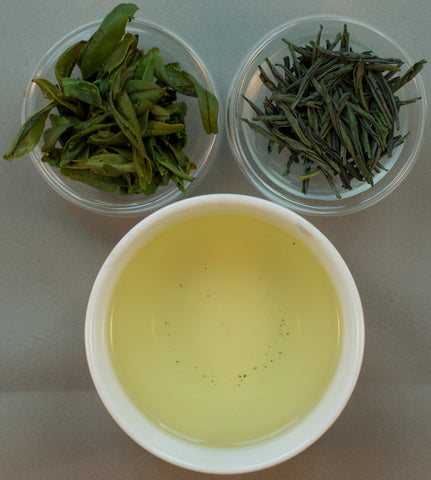Houjicha is a popular Japanese green tea. The dark color is due to the roasting process, which smooths out the bitterness and brings out beautiful aromatic, savory and smoky flavors.
Most houjicha is crafted from lower grade, autumn harvest leaves. However, this tea from the Kinezuka Family is crafted from Spring leaves, harvested in May. These young, tender leaves yield a stronger, more robust flavor and the tea lasts for many more infusions.
The roasting process is said to reduce the amount of caffeine to levels less than decaffeinated tea, but I’m not sure why that would be so I will reserve an opinion until I see some science behind the claim. That being said, the sweetness and lower caffeine content makes it popular for children and evening tea in Japan, so there might be something to it. It is also very easy to brew. The Japanese often drink it hot in the winter and cold in the summer.
This wonderful tea is from the small, completely organic Kinezuka farm in Shizuoka. Their natural growing practices are an anomaly in the midst of Japan’s typically heavy use of chemicals in their industrialized tea industry.
Provenance:
-
Origin: Nakayama Village in Fujieda, Shizuoka, Japan
-
Elevation: 350m (1150ft)
-
Grower/Teamaster: Kinezuka Family/Ayumi Kinezuka
-
Harvest Date: Spring 2021
-
Roast Date: Autumn 2021
-
Cultivar: Yabukita
-
Cultivation: Natural (Organic, no cert.) Toshiaki Kinezuka started farming with all-natural methods back in 1976, so the farm has been grown with organic practices for 38 years.
-
History/Pedigree: popular for children and evening tea in Japan; often served hot in the winter and cold in the summer
Brewing Suggestions1:
-
Water: 170˚-190˚F
-
Tea: 2g per 4oz of water (about a level 1 TB2)
-
Infusion: 2 minutes for 2-3 infusions
Tasting Notes:
- warm, sweet flavors with savory undertones are reminiscent of salted caramel
1 Brewing suggestions are just that. Try it the suggested way then experiment. In this case I suggest first experimenting with the temperature and infusion time. Different flavor profiles can be drawn out with temperature. The roast also allows this tea to stay in the water a long time, if that gives the desired flavors. Cold-brews great for iced tea! Some tea drinkers like to use slightly hotter and longer times for each subsequent infusion.
2 Weighing your tea is always the best way to control your dosage. I provide approximate volume measures for convenience but they can be problematic due to the variance in tea leaf shape and size. It’s best to use the single appropriate volume measure for the tea, i.e., don’t try to measure 1.5TB using two spoons meant to measure 1 TB and a ½ TB. Use an actual 1.5 TB measuring spoon. Yes, they make them! I like the oblong ones to handle longer leaf styles.



